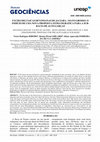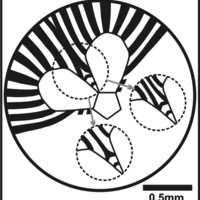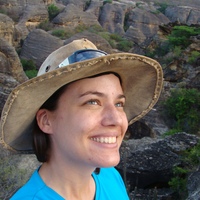Papers by Renato Ghilardi
Geosciences = Geociências
The genus Lingulapholis had temporal and spatial restrictions during the Devonian, being found on... more The genus Lingulapholis had temporal and spatial restrictions during the Devonian, being found only in Colombia and the United States. In Brazil, its related taxa Craniops is common in the Amazonas, Paraná, and Parnaíba basins. New data from the cities of Picos and Itainópolis, east flank of Parnaíba Basin, led to the discovery of a yet previously undescribed brachiopod genus for this region of Gondwana. The Lingulapholis brachiopod was found associated with plant fragments under conditions of moderate to low hydrodynamic energy as indicated by ichnological assemblage, in proximal expressions of Cruziana ichnofacies alternated to Skolithos ichnofacies. The presence of Lingulapholis suggests that the Parnaíba Basin was inserted in the zone of diffuse faunal mixing during the Middle Devonian.

Geosciences = Geociências
O Devoniano da bacia do Paraná é caracterizado pela consolidação de duas sub-bacias, uma ao sul c... more O Devoniano da bacia do Paraná é caracterizado pela consolidação de duas sub-bacias, uma ao sul chamada sub-bacia Apucarana e outra ao norte chamada sub-bacia Alto Garças. Diferenças paleoambientais são notadas em ambas bacias, na sub-bacia Alto Garças as diferenças são laterais: fácies terrígenas deltáicas se estabeleceram na margem norte enquanto que fácies marinhas reinam à noroeste. Na região de Jaciara-MT, flanco noroeste da sub-bacia Alto Garças, as rochas devonianas aflorantes foram descritas apenas contendo fácies de mar aberto, no entanto aqui apresentamos novos empilhamentos estratigráficos, ambientes deposicionais e concentrações fossilíferas. Foram individualizados várias subunidades deposicionais, sendo elas da base para o topo; fácies de mar aberto com fósseis bastante representativos da fauna Malvinocáfrica (exemplares de Lingulídeos, Orbiculoidea sp., Australocoelia sp., Notiochonetes sp. e Australospirifer sp.), fácies de frente deltaica influenciada pela ação das m...

Boletim do Museu Paraense Emílio Goeldi - Ciências Naturais
Restos de macroinvertebrados marinhos são os componentes mais conspícuos da biota paleozoica, pri... more Restos de macroinvertebrados marinhos são os componentes mais conspícuos da biota paleozoica, principalmente no Paleozoico inferior e médio. Conchas e carapaças fossilizadas de braquiópodes, trilobitas, bivalves e, em menor número, gastrópodes, crinoides, briozoários, esteleroides e corais, além de outros grupos extintos como os blastoides, os conulários, os hiolitídeos e os tentaculitídeos, são abundantes nos depósitos fossilíferos dessa era. O estudo das tafocenoses de macroinvertebrados marinhos paleozoicos, além de resgatar parcialmente a diversidade biológica do passado, fornece dados úteis às reconstruções de natureza paleoecológica, paleoambiental, paleobiogeográfica e paleogeográfica. O padrão de distribuição geográfica de determinados táxons em particular, assim como de suas associações, possibilita a inferência de dados que podem auxiliar na reconstituição de unidades paleobiogeográficas e de geografias pretéritas. No Brasil, os macroinvertebrados marinhos tornam-se numerosos e diversificados no registro sedimentar de idade devoniana. Eles ocorrem em abundância nas principais bacias paleozoicas brasileiras, principalmente nas bacias do Amazonas, do Paraná e do Parnaíba (Figura 1). As faunas de invertebrados marinhos do Devoniano, em geral, indicam um provincialismo crescente a partir do início deste período, que atingiu seu máximo no final do Eodevoniano (Praguiano-Emsiano). Durante o Mesodevoniano, o grau de endemismo das formas de braquiópodes, corais, trilobitas, bivalves e outros grupos começou a diminuir, culminando, por exemplo, com o cosmopolitismo quase total de famílias e gêneros de braquiópodes no Neodevoniano (Frasniano-Fameniano) (Boucot, 1988). Boucot et al. (1969) e Boucot (1975) definiram três principais unidades paleobiogeográficas presentes no Eodevoniano-Mesodevoniano, baseados principalmente em braquiópodes: o Domínio do Velho Mundo, o Domínio das Américas Orientais e o Domínio Malvinocáfrico. Segundo Boucot (1988), o Domínio do Velho Mundo ocupava as baixas latitudes, possuindo águas quentes características das regiões tropicais e subtropicais. Desenvolveu-se em áreas hoje correspondentes à Europa e à Ásia, ao norte da África, à Austrália, à Nova Zelândia e ao noroeste da América do Norte (Boucot, 1975). O Domínio Malvinocáfrico ocupava as altas latitudes no hemisfério sul, apresentando características litológicas indicativas de águas frias, periglaciais, e uma fauna altamente endêmica e pouco diversificada, como é o caso do

Revista Brasileira de Paleontologia, 2021
A taxonomic review of Miocene gastropods from the Solimões Formation, Acre Basin, Brazil, from sp... more A taxonomic review of Miocene gastropods from the Solimões Formation, Acre Basin, Brazil, from specimens collected at Cachoeira do Bandeira, Oriente, and an outcrop named Spot 04, is here presented. Three ampullariid species (Pomacea maculata, P.planorbula, Pomacea sp.), one thiarid species (Aylacostoma sp.), and one cochliopid species (Sioliella sp.) are identified for these deposits. These gastropod are known to occur in freshwaters environments, thus consolidating the hypothesis of a non-influence of brackish water on the upper Miocene deposits of the Acre Basin. The previous identification of P. maculata and Aylacostoma sp. is changed here considering biometrical analyses and shell morphological descriptions. The first report of Sioliella in this basin increases the gastropod fauna known for these strata and expands the range of this genus. Keywords: Pomacea, Aylacostoma, Sioliella, Ampullariidae, Thiaridae, Cochliopidae.

Brazilian Journal of Geology, 2018
Studies that integrate ichnologic, taphonomic and sedimentologic data result in more accurate pal... more Studies that integrate ichnologic, taphonomic and sedimentologic data result in more accurate paleoenvironmental inferences than isolated approaches. Most of paleontological studies regarding Devonian from Paraná Basin were conducted in the southern part of the basin (Paraná state), precluding taphonomic or ichnologic studies to the northern part, and even its macrofossils content is understudied. This study analyzes paleoecologic and depositional conditions represented by trace fossils, macrofossils and sedimentary facies in a regressive Devonian section from Paraná Basin, Mato Grosso do Sul state, Brazil. Seven ichnofabrics (Macaronichnus, Psammichnites, Arenicolites-Skolithos, Cylindrichnus-Skolithos, Zoophycos, Rhizocorallium-Palaeophycus, and Chondrites ichnofabrics) and three taphofacies (T1: parautochthonous to allochthonous preservation; T2: Autochthonous preservation; and T3: time-averaged autochthonous to allochthonous association) were diagnosed. The studied sections are positioned in a highstand systems tract (HST) exhibiting dominance of sandy facies, and four sub-environments were defined: foreshore; shoreface; storm-dominated shoreface to transitional offshore; and offshore. The dominance of foreshore to shoreface settings in a HST corroborates a shallower context in relation to the southern part. However, similarities in the facies and ichnofacies stacking, as well in the macrofossil content suggest that the hypothetical division between two sub-basins (Apucarana and Alto Garças Sub-basins) was not complete until early Emsian.

PALAIOS, 2018
Fossil data collecting is an essential stage of every paleontological undertaking. Although there... more Fossil data collecting is an essential stage of every paleontological undertaking. Although there is a consensus regarding the fundamental importance of sedimentary and stratigraphic context, there is still some debate surrounding the need to record the exact position of a fossil in relation to other elements within the same deposit (provenance). Here we provide a practical guide for the in-field use of the Total Station (TST, electronic equipment for xyz coordinates measurements), a tool that has seen wide application in archaeology but has been largely neglected in paleontology. With the TST, recording the provenance of in situ fossils can be done quickly and with great precision. We also present a configuration tutorial showing how to use the equipment, based on our experience in the Solimões Formation (upper Miocene, Acre basin, Brazil), highlighting both its advantages and disadvantages for recording fossil provenances.
Terr Plural, 2021
Recent fieldwork in the state of Mato Grosso made it possible to find new specimens of trilobites... more Recent fieldwork in the state of Mato Grosso made it possible to find new specimens of trilobites, among them: Metacryphaeus australis, Metacryphaeus sp., and a homalonotide. Taphonomically, it was possible to observe that there are two patterns of conservation, one of which is where the specimens are complete, related to a rapid burial event; and another pattern of preservation where paleoenvironmental conditions provided disarticulation after death. These new findings, as well as their taphonomic interpretations, open possibilities to work on biostratigraphic correlations, in addition to paleobiogeographic assessments for trilobites in South America.
Page 1. 113 Terr@Plural, Ponta Grossa, v.4, n.1, p.113-119, jan./jun. 2010. Anatomia interna de a... more Page 1. 113 Terr@Plural, Ponta Grossa, v.4, n.1, p.113-119, jan./jun. 2010. Anatomia interna de alguns moluscos bivalves fósseis do grupo Bauru (cretáceo superior, Bacia Bauru), Brasil: implicações paleoecológicas Internal ...
... Renato Pirani Ghilardi I ; Fernando César Paiva D'Ágosta I ; Kléber Alves... more ... Renato Pirani Ghilardi I ; Fernando César Paiva D'Ágosta I ; Kléber Alves I ; Antonio Celso de Arruda Campos II. ... De fato, Tevesz & McCall (1979) já demonstram que os bivalves dulcícolas não respondem tão especificamente ao substrato como os bivalves marinhos. ...
Pesquisas em Geociências, 2000
Palaeogeography, Palaeoclimatology, Palaeoecology

Palaeogeography, Palaeoclimatology, Palaeoecology
Taphofacies of Malvinokaffric macroinvertebrate-bearing rocks from the uppermost Pragian to lower... more Taphofacies of Malvinokaffric macroinvertebrate-bearing rocks from the uppermost Pragian to lower Givetian in southwestern Gondwana are evaluated. During the Lower/Middle Devonian, the Paraná Basin (southern Brazil) was positioned at high latitudes in southwestern Gondwana (60°to 80°S). Integrated litho-and taphofacies interpretations in siliciclastic environments presented here provide paleoecological and paleoenvironmental insights. The six taphofacies recognized here showed changing depositional conditions in paleoenvironments ranging from shoreface to offshore shelf settings. They vary in recurrence and abundance, but all facies exhibit evidence of storm events. Winter storms are to be expected at latitudes 60°to 80°S under cool climate zone. Storm-related taphofacies recurrence during the latest Pragian to early Givetian points to two agents of sedi-mentation, direct wave erosion by winter storms and sedimentary processes related to combined flow during deposition (e.g. turbidity currents and oscillatory flow). Winter storms are considered more capable of affecting sediment transport than hurricanes, due to longer duration and larger coverage area in higher latitudes. Therefore, winter storms of high latitudes should generate more persistent currents in space and time. Finally, the taphofacies, lithofacies and high-latitude paleogeographic context of the Paraná Basin suggest the action of storm-influence in the genesis of all Lower/Middle Devonian Malvinokaffric assemblages here recognized.
Revista Brasileira de Paleontologia
A long-lived marine seaway between the Parnaíba and Paraná basins occurred during a global marine... more A long-lived marine seaway between the Parnaíba and Paraná basins occurred during a global marine transgression between Brazilian intracratonic basins (except for the Solimões Basin) in the latest Eifelian/earliest Givetian (Middle Devonian). As a result of this transgression a catastrophic event (KAČÁK) in combination with the immigration of warm water Appalachian and Old World faunas contributed to the collapse of the Malvinokaffric Realm in the Paraná Basin. In the Alto Garҫas and Apucarana sub-basins, the transgression is notable in the early Givetian with an impoverished shelly fauna following the KAČÁK post-extinction event in the earliest Givetian.
Boletim Do Museu Paraense Emilio Goeldi Ciencias Naturais, Aug 1, 2011
... Renato Pirani Ghilardi I ; Fernando César Paiva D'Ágosta I ; Kléber Alves... more ... Renato Pirani Ghilardi I ; Fernando César Paiva D'Ágosta I ; Kléber Alves I ; Antonio Celso de Arruda Campos II. ... De fato, Tevesz & McCall (1979) já demonstram que os bivalves dulcícolas não respondem tão especificamente ao substrato como os bivalves marinhos. ...
Terr Plural, Feb 20, 2014
Resumo: O presente trabalho trata do levantamento histórico da classe para as camadas devonianas,... more Resumo: O presente trabalho trata do levantamento histórico da classe para as camadas devonianas, características gerais e padrões de preservação tafonômicos associados ao grupo. Foram analisados exemplares localizados em coleções científicas de museus e universidades brasileiras. O grupo taxonômico é representado por quatro gêneros nas bacias do Paraná, do Parnaíba e do Amazonas: Tentaculites, Homoctenus, Styliolina e Volynites. Os tentaculitídeos ocorrem desde o Ordoviciano até o Devoniano e atingiram seu ápice no Devoniano Médio. A Classe possui três ordens conhecidas: Tentaculitida, animais de hábito bentônico, Homoctenida e Dacryconarida, animais de hábito planctônico. Notou-se a presença de dois padrões de preservação tafonômico: espécimes isolados e agrupados.
Revista Espanola De Paleontologia, 2000
Biblioteca de la Universidad Complutense de Madrid, Base de datos de artículos de revistas, ...
Brazilian Geographical Journal Geosciences and Humanities Research Medium, Dec 25, 2010
Representing visually the external appearance of an extinct animal requires, for a reasonably rel... more Representing visually the external appearance of an extinct animal requires, for a reasonably reliable and expressive reconstitution, a good compilation and arrangement of the scientific conclusions on the fossil findings. It is proposed in this work an initial model of a briefing to be applied in a paleodesign process of a paleovertebrate. Briefing can be understood as a gathering of all necessary data to perform a project. We point out what must be known about the relevant structures in order to access all the data and the importance of such information. It is expected that the present briefing suggested might be faced with flexibility, serving as a facilitating interface of the relation between paleoartists and paleontologists.
Terr Plural, Feb 20, 2014
Estabelece-se aqui o histórico de pesquisas desenvolvidas em trilobitas na Bacia do Paraná, Brasi... more Estabelece-se aqui o histórico de pesquisas desenvolvidas em trilobitas na Bacia do Paraná, Brasil. Desde o clássico trabalho monográfico de J. M. Clarke até o presente várias fases de desenvolvimento científico ocorreram, a saber: uma primeira fase de prospecção de material, uma segunda fase de estudos sistemáticos e uma terceira fase com a consolidação dos conceitos adquiridos. Adicionalmente, discutemse as espécies de trilobitas descritas para o devoniano da Bacia do Paraná, elencando as espécies válidas. Por fim, apresentam-se comentários sobre o desenvolvimento das pesquisas paleontológicas brasileiras, principalmente no que se refere ao estudo de trilobitas.










Uploads
Papers by Renato Ghilardi